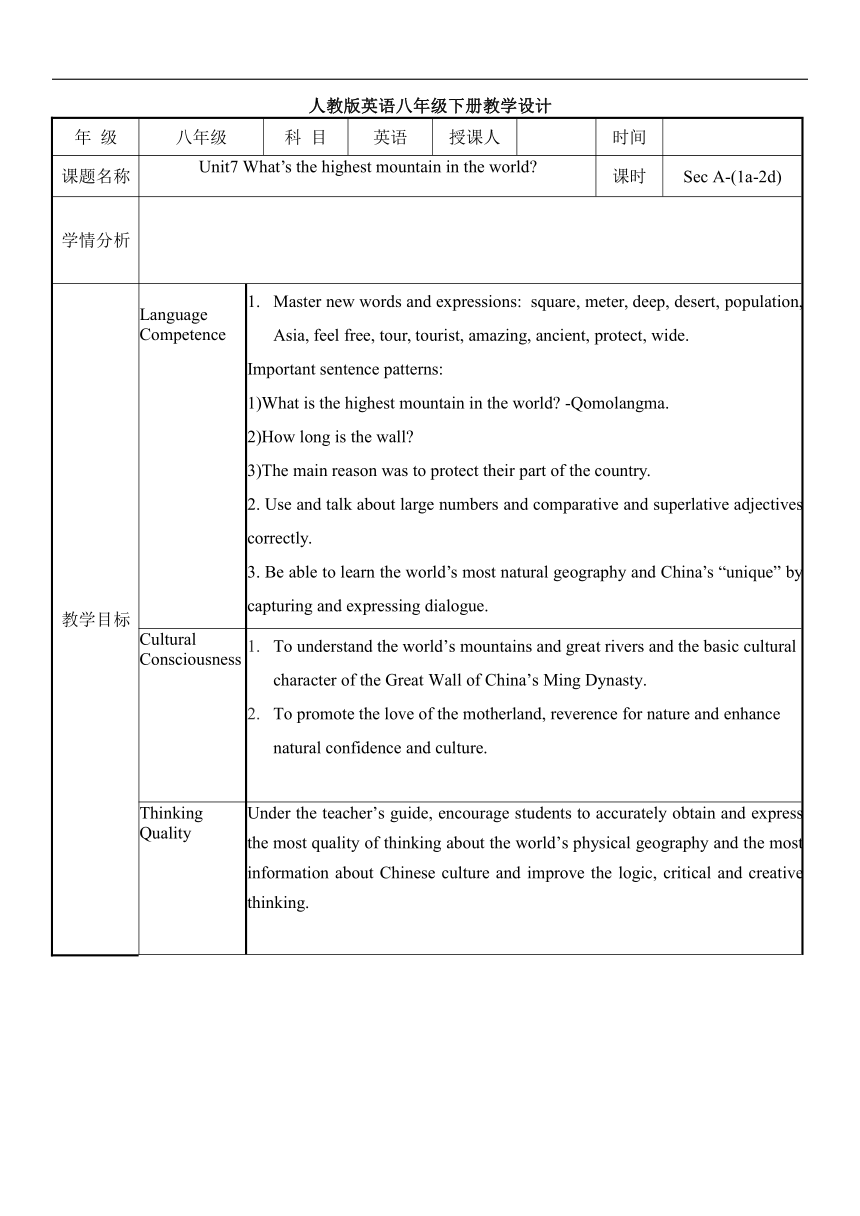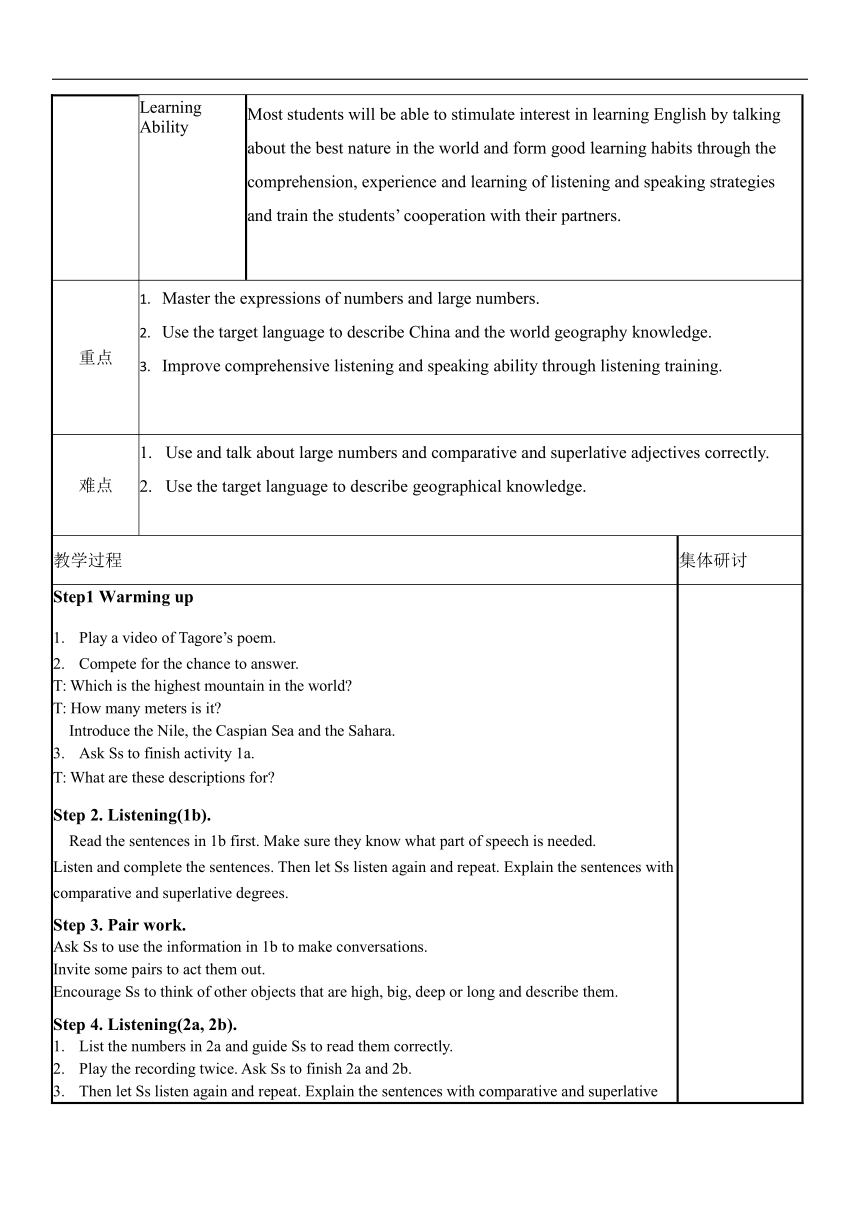Unit 7 What's the highest mountain in the world? SectionA(1a-2d)教案
文档属性
| 名称 | Unit 7 What's the highest mountain in the world? SectionA(1a-2d)教案 |

|
|
| 格式 | docx | ||
| 文件大小 | 597.1KB | ||
| 资源类型 | 教案 | ||
| 版本资源 | 人教新目标(Go for it)版 | ||
| 科目 | 英语 | ||
| 更新时间 | 2024-03-08 15:00:45 | ||
图片预览


文档简介
人教版英语八年级下册教学设计
年 级 八年级 科 目 英语 授课人 时间
课题名称 Unit7 What’s the highest mountain in the world 课时 Sec A-(1a-2d)
学情分析
教学目标 Language Competence Master new words and expressions: square, meter, deep, desert, population, Asia, feel free, tour, tourist, amazing, ancient, protect, wide. Important sentence patterns: 1)What is the highest mountain in the world -Qomolangma. 2)How long is the wall 3)The main reason was to protect their part of the country. 2. Use and talk about large numbers and comparative and superlative adjectives correctly. 3. Be able to learn the world’s most natural geography and China’s “unique” by capturing and expressing dialogue.
Cultural Consciousness To understand the world’s mountains and great rivers and the basic cultural character of the Great Wall of China’s Ming Dynasty. To promote the love of the motherland, reverence for nature and enhance natural confidence and culture.
Thinking Quality Under the teacher’s guide, encourage students to accurately obtain and express the most quality of thinking about the world’s physical geography and the most information about Chinese culture and improve the logic, critical and creative thinking.
Learning Ability Most students will be able to stimulate interest in learning English by talking about the best nature in the world and form good learning habits through the comprehension, experience and learning of listening and speaking strategies and train the students’ cooperation with their partners.
重点 Master the expressions of numbers and large numbers. Use the target language to describe China and the world geography knowledge. Improve comprehensive listening and speaking ability through listening training.
难点 Use and talk about large numbers and comparative and superlative adjectives correctly. Use the target language to describe geographical knowledge.
教学过程 集体研讨
Step1 Warming up Play a video of Tagore’s pete for the chance to answer. T: Which is the highest mountain in the world T: How many meters is it Introduce the Nile, the Caspian Sea and the Sahara. Ask Ss to finish activity 1a. T: What are these descriptions for Step 2. Listening(1b). Read the sentences in 1b first. Make sure they know what part of speech is needed. Listen and complete the sentences. Then let Ss listen again and repeat. Explain the sentences with comparative and superlative degrees. Step 3. Pair work. Ask Ss to use the information in 1b to make conversations. Invite some pairs to act them out. Encourage Ss to think of other objects that are high, big, deep or long and describe them. Step 4. Listening(2a, 2b). List the numbers in 2a and guide Ss to read them correctly. Play the recording twice. Ask Ss to finish 2a and 2b. Then let Ss listen again and repeat. Explain the sentences with comparative and superlative degrees. Step 5. Group work. Ask Ss to make conversations in groups of four using the information in 2a. Some tips are provided. Step 6. Role-play. Present some questions: What is the conversation about How long is the Ming Great Wall What does the guide say about the wall Then ask Ss to fill in the blanks. Then let Ss listen again and repeat. Explain the language points. Step 7. Conclusion. T: No matter how big the world is, home is the warmest harbor.
Unit 7 A(1a---2d)
教学反思
年 级 八年级 科 目 英语 授课人 时间
课题名称 Unit7 What’s the highest mountain in the world 课时 Sec A-(1a-2d)
学情分析
教学目标 Language Competence Master new words and expressions: square, meter, deep, desert, population, Asia, feel free, tour, tourist, amazing, ancient, protect, wide. Important sentence patterns: 1)What is the highest mountain in the world -Qomolangma. 2)How long is the wall 3)The main reason was to protect their part of the country. 2. Use and talk about large numbers and comparative and superlative adjectives correctly. 3. Be able to learn the world’s most natural geography and China’s “unique” by capturing and expressing dialogue.
Cultural Consciousness To understand the world’s mountains and great rivers and the basic cultural character of the Great Wall of China’s Ming Dynasty. To promote the love of the motherland, reverence for nature and enhance natural confidence and culture.
Thinking Quality Under the teacher’s guide, encourage students to accurately obtain and express the most quality of thinking about the world’s physical geography and the most information about Chinese culture and improve the logic, critical and creative thinking.
Learning Ability Most students will be able to stimulate interest in learning English by talking about the best nature in the world and form good learning habits through the comprehension, experience and learning of listening and speaking strategies and train the students’ cooperation with their partners.
重点 Master the expressions of numbers and large numbers. Use the target language to describe China and the world geography knowledge. Improve comprehensive listening and speaking ability through listening training.
难点 Use and talk about large numbers and comparative and superlative adjectives correctly. Use the target language to describe geographical knowledge.
教学过程 集体研讨
Step1 Warming up Play a video of Tagore’s pete for the chance to answer. T: Which is the highest mountain in the world T: How many meters is it Introduce the Nile, the Caspian Sea and the Sahara. Ask Ss to finish activity 1a. T: What are these descriptions for Step 2. Listening(1b). Read the sentences in 1b first. Make sure they know what part of speech is needed. Listen and complete the sentences. Then let Ss listen again and repeat. Explain the sentences with comparative and superlative degrees. Step 3. Pair work. Ask Ss to use the information in 1b to make conversations. Invite some pairs to act them out. Encourage Ss to think of other objects that are high, big, deep or long and describe them. Step 4. Listening(2a, 2b). List the numbers in 2a and guide Ss to read them correctly. Play the recording twice. Ask Ss to finish 2a and 2b. Then let Ss listen again and repeat. Explain the sentences with comparative and superlative degrees. Step 5. Group work. Ask Ss to make conversations in groups of four using the information in 2a. Some tips are provided. Step 6. Role-play. Present some questions: What is the conversation about How long is the Ming Great Wall What does the guide say about the wall Then ask Ss to fill in the blanks. Then let Ss listen again and repeat. Explain the language points. Step 7. Conclusion. T: No matter how big the world is, home is the warmest harbor.
Unit 7 A(1a---2d)
教学反思
同课章节目录
- Unit 1 What's the matter?
- Section A
- Section B
- Unit 2 I'll help to clean up the city parks.
- Section A
- Section B
- Unit 3 Could you please clean your room?
- Section A
- Section B
- Unit 4 Why don't you talk to your parents?
- Section A
- Section B
- Unit 5 What were you doing when the rainstorm came
- Section A
- Section B
- Review of Units 1-5
- Unit 6 An old man tried to move the mountains.
- Section A
- Section B
- Unit 7 What's the highest mountain in the world?
- Section A
- Section B
- Unit 8 Have you read Treasure Island yet?
- Section A
- Section B
- Unit 9 Have you ever been to a museum?
- Section A
- Section B
- Unit 10 I've had this bike for three years.
- Section A
- Section B
